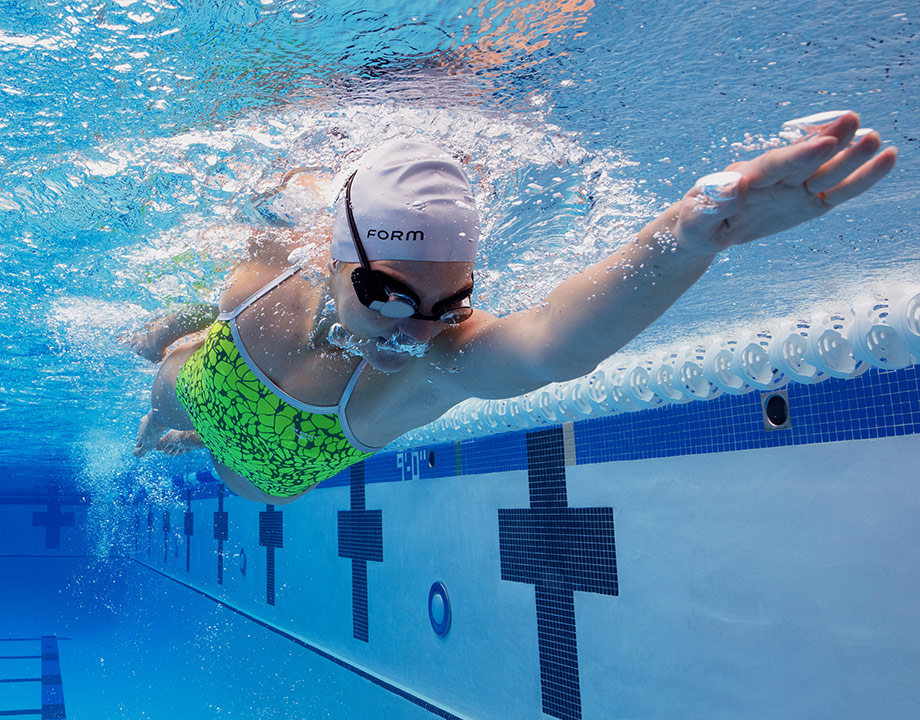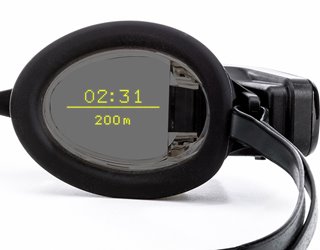AR Goggles for Swimmers
AR Goggles for Swimmers


Form Goggles help swimmers track their metrics with an aquatic AR display. Photo: Form
There are loads of electronic devices on the market that allow fitness enthusiasts to keep track of their workouts, spitting out megabytes of performance metrics in real time. Strapped to a wrist or displayed on a machine, speed, time, distance, and heart rate are there for immediate analysis.
One sport, however, has lagged in electronic monitoring and, now, a marriage of augmented reality and computer analytics is bringing the technology to swimmers.
A new pair of swim goggles fitted with augmented reality brings training metrics right to the swimmer’s face, or more specifically, their eyes. The combination of AR and a small onboard computer tucked on the side measures a variety of metrics and displays the information on either the left or the right lens. That discreetly brings the information directly to the swimmer without having to check a wrist device or listen to a coach.
Developed by Form, a British Columbia startup, the goggles are the brainchild of the company’s founder Dan Eisenhardt. A former competitive swimmer, as well as a mechanical engineer, he had earlier success in developing smart ski goggles, eventually selling his firm Recon Instruments to Intel.
“In skiing, you have huge goggles and 95 percent of the people were already wearing them,” he said. “We could make something clipped into the bottom. At the time, the reason we went away [from swim goggles] was size constraint.”
The evolution of technology removed that obstacle. “Back in 2016 I incorporated the company and I knew I could pull it off. We had five generations of smart goggles and glasses for cycling.”
Watch Related Video: How AR Works in the Real World
Swim goggles presented other challenges. To see through the display, Eisenhardt had to come up with a new optical solution while keeping costs low and not adding any significant weight, he said.
It was important that the optics were not seen from the outside and that the display could be seen from either side of the goggles. (The swimmer has the option of displaying the metrics on either the left or the right eye.) “If you can’t see the display, it doesn’t matter how nice the goggles are.”
The goggles are programmed using two buttons to power on and off and choose and display up to 12 metrics. It also can be done through an app that connects with coaches or friends.
The user can decide which metrics to display and when: during rest, after turns, or while swimming. Only two are shown at the same time but swimmers can program the goggles to show different information at intervals during the workout.
The computer is positioned on the side of the goggle, which limits peripheral vision. For a quick start, swimmers can select the swim mode, enter the length of the pool, and dive in. The processor recognizes the accelerometer signals as whatever stroke is being used, and identifies turns and rest.
Eisenhardt said the goggles are marketed to competitive swimmers and triathletes for training. The technology is not allowed during sanctioned events. “They spend 99.9 percent of their time training,” he said. “It is hard to keep track [of metrics] during training. This is a tool to make you much better.”
Further Reading: Iron Man Lives
To do that, Eisenhardt and his team used a 3D printer early in the design process to speed the time between iterations. “It paid for itself within a week,” he said. The goggles are made from plastic with silicone to provide eye seal. The anti-fog is the same one used in diving masks.
“We had to go with a higher grade of materials because you’re not going to buy two or three pairs of these goggles per year,” he said. At a retail price of $200, they are much more expensive than standard goggles but are designed to last much longer.
“There were lots of constraints in engineering,” noted Eisenhardt. “It goes back to the size of the battery [with a 16-hour life] and not to create too much drag in the water. From an algorithm perspective we want to increase accuracy so more and more swimmers get better data.”
John Kosowatz is senior editor.
One sport, however, has lagged in electronic monitoring and, now, a marriage of augmented reality and computer analytics is bringing the technology to swimmers.
A new pair of swim goggles fitted with augmented reality brings training metrics right to the swimmer’s face, or more specifically, their eyes. The combination of AR and a small onboard computer tucked on the side measures a variety of metrics and displays the information on either the left or the right lens. That discreetly brings the information directly to the swimmer without having to check a wrist device or listen to a coach.
Developed by Form, a British Columbia startup, the goggles are the brainchild of the company’s founder Dan Eisenhardt. A former competitive swimmer, as well as a mechanical engineer, he had earlier success in developing smart ski goggles, eventually selling his firm Recon Instruments to Intel.
“In skiing, you have huge goggles and 95 percent of the people were already wearing them,” he said. “We could make something clipped into the bottom. At the time, the reason we went away [from swim goggles] was size constraint.”
The evolution of technology removed that obstacle. “Back in 2016 I incorporated the company and I knew I could pull it off. We had five generations of smart goggles and glasses for cycling.”
Watch Related Video: How AR Works in the Real World
Swim goggles presented other challenges. To see through the display, Eisenhardt had to come up with a new optical solution while keeping costs low and not adding any significant weight, he said.
It was important that the optics were not seen from the outside and that the display could be seen from either side of the goggles. (The swimmer has the option of displaying the metrics on either the left or the right eye.) “If you can’t see the display, it doesn’t matter how nice the goggles are.”
The goggles are programmed using two buttons to power on and off and choose and display up to 12 metrics. It also can be done through an app that connects with coaches or friends.
The user can decide which metrics to display and when: during rest, after turns, or while swimming. Only two are shown at the same time but swimmers can program the goggles to show different information at intervals during the workout.
The computer is positioned on the side of the goggle, which limits peripheral vision. For a quick start, swimmers can select the swim mode, enter the length of the pool, and dive in. The processor recognizes the accelerometer signals as whatever stroke is being used, and identifies turns and rest.
Eisenhardt said the goggles are marketed to competitive swimmers and triathletes for training. The technology is not allowed during sanctioned events. “They spend 99.9 percent of their time training,” he said. “It is hard to keep track [of metrics] during training. This is a tool to make you much better.”
Further Reading: Iron Man Lives
To do that, Eisenhardt and his team used a 3D printer early in the design process to speed the time between iterations. “It paid for itself within a week,” he said. The goggles are made from plastic with silicone to provide eye seal. The anti-fog is the same one used in diving masks.
“We had to go with a higher grade of materials because you’re not going to buy two or three pairs of these goggles per year,” he said. At a retail price of $200, they are much more expensive than standard goggles but are designed to last much longer.
“There were lots of constraints in engineering,” noted Eisenhardt. “It goes back to the size of the battery [with a 16-hour life] and not to create too much drag in the water. From an algorithm perspective we want to increase accuracy so more and more swimmers get better data.”
John Kosowatz is senior editor.





